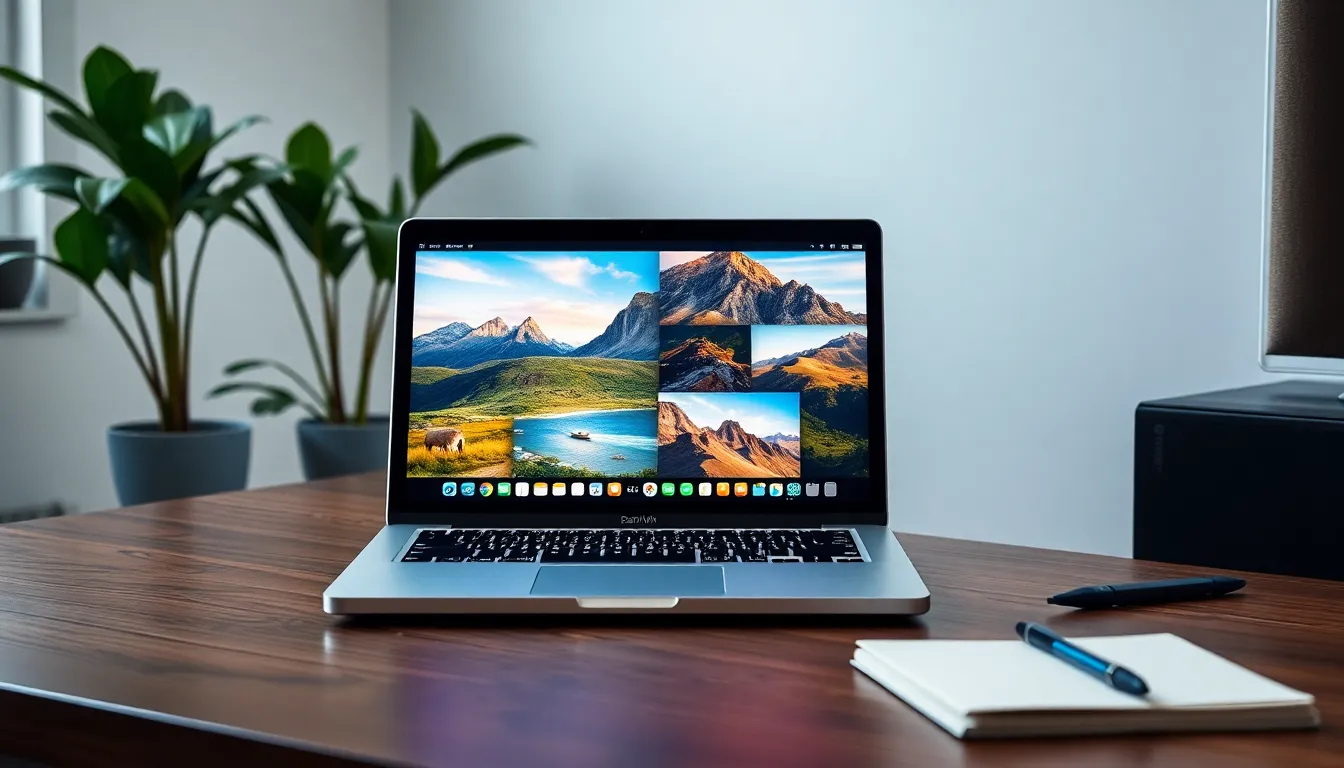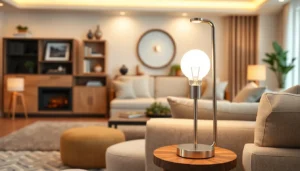In today’s digital age, choosing the right laptop involves more than just picking a brand or model. One crucial factor that often gets overlooked is display resolution. With a variety of options available, understanding how each resolution impacts visual clarity and overall user experience can make all the difference.
From everyday tasks to graphic design and gaming, the resolution determines how sharp and vibrant images appear on the screen. Whether it’s Full HD, 4K, or something in between, each resolution offers distinct advantages and drawbacks. This article dives into the nuances of laptop resolutions, helping readers make informed decisions tailored to their specific needs.
Table of Contents
ToggleOverview of Laptop Resolutions
Laptop resolutions determine the clarity and detail of images displayed on screens. Various resolutions cater to a range of user needs and preferences.
Common Laptop Resolutions
- HD (1366 x 768): Offers basic clarity suitable for everyday tasks like web browsing and document editing. It’s often found in budget laptops.
- Full HD (1920 x 1080): Provides a significant improvement in visual quality. Ideal for streaming videos and casual gaming, making it a popular choice among users.
- Quad HD (2560 x 1440): Balances image detail and performance. Great for multitasking and creative work, it delivers sharper visuals than Full HD.
- 4K Ultra HD (3840 x 2160): Delivers exceptional detail, ideal for professional editing and high-definition content consumption. Requires more powerful hardware, so it’s common in high-end laptops.
Advantages and Disadvantages
- Higher Resolutions:
- Offer improved image sharpness and detail.
- Enhance gaming experiences with vibrant visuals.
- Require more powerful graphics cards and processors.
- Lower Resolutions:
- Require less processing power, allowing for longer battery life.
- Typically lower in price, making them accessible to budget-conscious consumers.
- May lack the clarity required for precise graphic work.
Choosing the Right Resolution
Selecting an appropriate resolution depends on user needs. A gamer might prefer a laptop with 4K capabilities for immersive experiences, whereas a casual user might find Full HD sufficient for daily tasks. Clarity, purpose, and budget all play roles in making the right choice.
Common Laptop Resolutions

Laptop display resolutions vary widely, impacting user experience across different applications. Understanding these common resolutions helps users select the best option for their needs.
Standard Resolutions
Standard resolutions include HD and Full HD.
- HD (1366 x 768): Offers basic clarity, suitable for web browsing and document editing. This resolution is prevalent in budget laptops and provides adequate performance for everyday tasks.
- Full HD (1920 x 1080): Delivers sharper images and enhanced detail. Full HD is widely used for streaming, gaming, and general use, making it a versatile choice for most users.
Ultra HD Resolutions
Ultra HD resolutions cater to users seeking superior visual experiences.
- Quad HD (2560 x 1440): Balances clarity and performance, ideal for graphic design and multitasking. This resolution delivers a crisp picture without overpowering the hardware, making it suitable for professional applications.
- 4K Ultra HD (3840 x 2160): Offers exceptional detail and clarity, vital for professional video editing and high-resolution content creation. 4K requires robust hardware to function smoothly, making it a premium choice for demanding tasks.
Factors to Consider in Resolution
When evaluating laptop resolutions, consider key factors that influence visual experience and performance. These factors include screen size and usage scenarios, which determine the most suitable resolution for various tasks.
Screen Size Impact
Screen size directly affects how resolution is perceived. Higher resolutions provide crisper images on larger screens, while lower resolutions may result in pixelation. For screens smaller than 15 inches, HD or Full HD resolutions suffice since they’re less noticeable. Larger screens, 17 inches or more, benefit from Quad HD or 4K resolutions for optimal clarity and detail. Choosing a resolution that complements screen size enhances overall viewing experience.
Usage Scenarios
Different usage scenarios dictate preferred resolutions. For basic tasks like web browsing, HD resolutions suffice. For streaming and casual gaming, Full HD strikes a balance between image quality and performance. Quad HD suits graphic design, providing detailed visuals without overwhelming hardware. Professional video editing and high-end gaming benefit from 4K, delivering stunning detail but requiring robust hardware. Awareness of specific needs directly influences resolution choice, enhancing productivity and satisfaction.
Pros and Cons of Different Resolutions
Evaluating laptop resolutions involves recognizing their advantages and limitations. Each resolution serves specific purposes and user preferences, impacting experiences and choices.
High Resolution Advantages
- Image Clarity: Higher resolutions, like Quad HD and 4K, deliver sharper images with more detail, enhancing visual experiences for photography, video editing, and gaming.
- Productivity: Higher pixel densities allow for more content on the screen, facilitating multitasking and productivity for professionals using design software or spreadsheets.
- Color Accuracy: Many high-resolution displays offer better color representation, benefiting tasks that require precise color work, such as graphic design and video production.
- Future-Proofing: Investing in a high-resolution laptop prepares users for emerging software and multimedia that demand greater resolution, ensuring relevance in a rapidly evolving digital landscape.
Low Resolution Limitations
- Image Quality: Lower resolutions, such as HD, can appear pixelated and less detailed, diminishing viewing experiences for media consumption and creative work.
- Limited Screen Real Estate: Reduced pixel counts restrict the amount of content visible on the screen, making it challenging for multitasking and productivity-oriented applications.
- Compatibility Issues: Certain applications and modern software expect higher resolutions, which can lead to compatibility problems on lower-resolution displays.
- Outdated Technology: Using low-resolution laptops might lead to quicker obsolescence, as software and media increasingly embrace higher resolutions, affecting user longevity and satisfaction.
Popular Laptops by Resolution
| Laptop Model | Resolution | Key Features |
|---|---|---|
| Acer Aspire 5 | HD (1366 x 768) | Budget-friendly, light web browsing, basic tasks |
| Dell XPS 13 | Full HD (1920 x 1080) | Compact design, great for streaming and multitasking |
| HP Spectre x360 | Quad HD (2560 x 1440) | Touchscreen, versatile for graphic design and productivity |
| MacBook Pro 16 | 4K Ultra HD (3840 x 2160) | Exceptional display, ideal for professional editing and high-end gaming |
| Lenovo ThinkPad X1 Carbon | Full HD (1920 x 1080) | Durable build, strong performance for office work |
| Razer Blade 15 | 4K Ultra HD (3840 x 2160) | High refresh rate, optimized for gaming experiences |
| ASUS ZenBook Pro 15 | Quad HD (2560 x 1440) | Stylish design, suitable for creative professionals |
Acer’s Aspire 5, with an HD resolution, fits users performing basic tasks efficiently. Dell’s XPS 13 excels in versatility, offering Full HD for streaming and daily use. HP’s Spectre x360 stands out with Quad HD, perfect for designers needing clarity. MacBook Pro 16 provides a 4K Ultra HD display, catering to professionals engaged in video editing. Lenovo ThinkPad X1 Carbon combines Full HD resolution with a robust design for business efficiency. Razer Blade 15 offers 4K Ultra HD, optimizing gaming visuals. Finally, ASUS ZenBook Pro 15 delivers Quad HD, appealing to creative professionals.
Selecting a laptop requires careful consideration of resolution alongside intended use, balancing performance and visual requirements.
Choosing the right laptop resolution is essential for maximizing user experience and productivity. Higher resolutions like 4K deliver stunning visuals and are perfect for professionals in design and gaming. However, they require robust hardware and may impact battery life.
On the other hand, lower resolutions like HD and Full HD cater to casual users who prioritize affordability and longer battery life. Ultimately, understanding individual needs and usage scenarios is crucial. By aligning resolution with specific tasks and preferences, users can make informed decisions that enhance their overall laptop experience.


